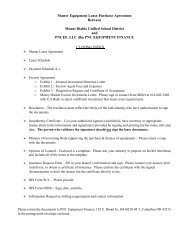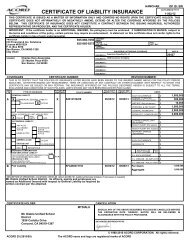Study of the Mount Diablo Unified School District - Mt. Diablo Unified ...
Study of the Mount Diablo Unified School District - Mt. Diablo Unified ...
Study of the Mount Diablo Unified School District - Mt. Diablo Unified ...
- No tags were found...
You also want an ePaper? Increase the reach of your titles
YUMPU automatically turns print PDFs into web optimized ePapers that Google loves.
Policies, Procedures, and Compliancedisability or keep a student in <strong>the</strong> general education classroom by remediating concernswithin <strong>the</strong> general realm. Therefore, staff adequately trained in skills beyond <strong>the</strong>ir gradelevel curriculum are less likely to submit a referral for special education or Section 504consideration because <strong>the</strong>y can effectively manage difficulties within <strong>the</strong>ir classroom. Staffwithout remediation and behavior management skills are more likely to seek help frompr<strong>of</strong>essionals outside <strong>the</strong>ir classroom.IDEA 2004 operationalized a pre‐referral (early intervention) approach called Response toIntervention (RTI) where students can be provided special education‐like intervention in <strong>the</strong>general education classroom without going through <strong>the</strong> expensive and extensive process <strong>of</strong>applying a label. Many schools demonstrate a similar tiered system <strong>of</strong> intervention byutilizing <strong>the</strong> Academic Success Center model.The RTI approach <strong>of</strong>fers three tiers as detailed in Exhibit 4‐4 below:EXHIBIT 4‐4RESPONSE TO INTERVENTION TIERSTier 3Specialized individualizedsystem for students withintensive needsTier 2Specialized group systemfor at-risk studentsTier 1<strong>School</strong> classroom-widesystem for all students,staff, and settings5%15%80%Source: http://www.rti4success.org, 2009.Tier 1 starts with strategies provided by a teacher within <strong>the</strong> general classroom. Tier 2strategies are gained through <strong>the</strong> CCT or SST processes via a brainstorming approach withteachers and support staff from within <strong>the</strong> building. All strategies are tried over <strong>the</strong> course<strong>of</strong> several weeks and <strong>the</strong> performance is documented. If <strong>the</strong> student does not improve, <strong>the</strong>process moves to Tier 3 where additional staff, such as a speech <strong>the</strong>rapist, schoolpsychologist, or a resource teacher, is included to assist with <strong>the</strong> difficulty by suggestingmore intensive methodology is employed. The student might be provided specialeducation‐like intervention, and successes (or failures) are documented. Once it isdocumented that a student is not performing well within <strong>the</strong> general realm with additionalassistance, <strong>the</strong> student might move to a formal referral resulting in testing for placement.MGT <strong>of</strong> America, Inc. Page 4‐8















